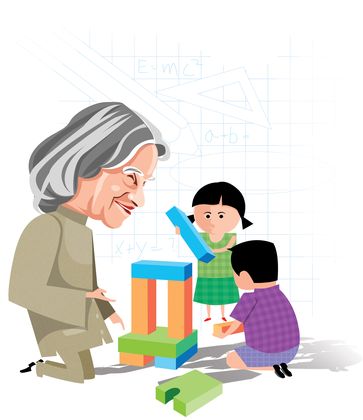WARREN BENNIS OF the University of California had an interesting observation about the future of work: “The factory of the future will have only two employees, a man and a dog; the man will be there to feed the dog, and the dog will be there to keep the man from touching the equipment!” Academic crystal-gazing is frequent and fecund in the world. But we do not need clairvoyance to see what kind of education India and the world needs for grooming the youth for an unknown future.
Peter Drucker observed in 1992, “…it is safe prediction that in the next fifty years schools and universities will change more and more distinctly than they have since they assumed their present form more than 300 years ago when they reorganized themselves around the printed book. What will force these changes is, in part, new technology… in part the demands of a knowledge-based society in which organized learning must become a lifelong process for knowledge workers, in part new theory about how human beings learn.”
What about the diverse learning styles we have neglected so far? Mark Zuckerberg wrote a letter to his newborn daughter, Max, in which he says, “Our generation grew up in classrooms where we all learned the same things at the same pace regardless of our interests or needs. Your generation will set goals for what you want to become—like an engineer, health worker, writer or community leader. You’ll have technology that understands how you learn best and where you need to focus. You’ll advance quickly in subjects that interest you most, and get as much help as you need in your most challenging areas. You’ll explore topics that aren’t even offered in schools today. Your teachers will also have better tools and data to help you achieve your goals.”
The writing is on the wall. Science and technology in their multiple avatars—AI, IOT (internet of things), ML (machine learning)—will lord over us. Even so, the future of work is confusingly opaque. If the future is VUCA (volatile, uncertain, complex, ambiguous), the kind of education needed to prepare the next generation for non-existent jobs puts a heavy premium on inculcating the “cope-ability” (Alvin Toffler) to change fast, frequently and without resistance. An average American shifts jobs five times in his lifetime. This is not possible without the gumption for re-skilling and guts for un-skilling. Good education instils this self-learning attitude, which is crucial for India.
Today’s students are already avid about accepting change. Youth enjoys that privilege of adaptability. But is our hamstrung education system changing? Are our teachers, change-friendly and change-efficient? Is pedagogy keeping pace with the ever changing demands? Are resources forthcoming speedily and liberally? We need to shake off this change-averse ostrich syndrome. Skilling and capacity building are the crying need of the times.
The results of world ranking of universities are an annual disappointment for India. The World Development Report, the surveys of PISA (Programme for International Student Assessment) and the findings of ASER (Annual Status of Education Report) only add insult to injury. Sample this, more than 50 per cent of fifth standard students cannot read text at the second standard [level], nor can they do single digit additions and subtractions. We have a “no-detention” policy to boot, which results in students being advanced to higher classes half-baked and ill-equipped. This flotsam will soon strike the tertiary shores. What can be salvaged? Will it supply robust building blocks for the nation?
The buzzwords today are innovation, cross-cutting approach, tangible learning outcomes, quality and excellence. Excellence is a fruit of rare cultivation; it does not grow on ordinary trees. Extraordinary outcomes call for extraordinary inputs. The new education policy offers some hope of specialised research institutes fuelled with liberal funding, though it seems to subordinate employability to liberal education. The NAAC (National Assessment and Accreditation Council) is also struggling to help colleges raise benchmarks. The results—grades of high performers are plummeting instead of escalating! This is due to lack of vision and lethargy to upskill. It is a casual approach. The slowest to change are the educational institutions when they are expected to be the harbingers of change! Let us not forget that casualness is the mother of mediocrity and the enemy of excellence.
And the scenario in the research departments; is there any innovation worth the salt? N.R. Narayana Murthy once raised the question, “Is there one innovation from India that has become a household name in the globe? No such contribution in the last 60 years.” This is about a country with around 40,000 colleges and 800 universities! Most of our PhD level research is like exhuming a corpse from one grave and interring it into another! It is either recycled or rancid plagiarism. Innovative research occupies the top-notch in world ranking. If you sow peanuts, you cannot reap almonds!
Now, the bottom-line: Mahatma Gandhi propagated education with the triple formula of head-heart-hand, clearly a combination of intellect, emotion and hard work. But the quality conundrum can be cracked only by competent and committed teachers, for they alone can instil inquisitiveness, and ethical and aesthetic values. That was why B.R. Ambedkar was vigilantly choosy about appointing teachers in his institutions. A.P.J. Abdul Kalam visualised science-centric education for the India of 2020. That surely is undeniable and inevitable. But science and technology do not answer all our questions. Kalam embodied an uncommon combination of science and culture, technology and poetry. We need to cultivate humanity. India of 2020 also wants students with Kalam’s calibre and compassion.
—Chindhade is a former member of the NAAC and a retired college principal.


